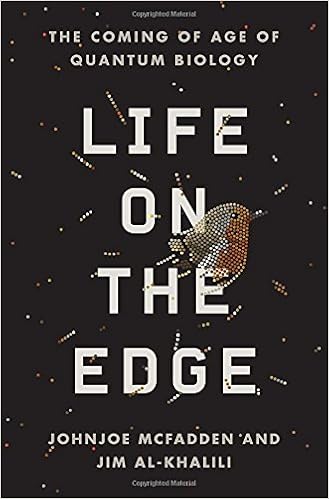Review: Life on the Edge: The Coming of Age of Quantum Biology by Johnjoe Mc Fadden and Jim Al-Khalili
Review: Life on the Edge: The Coming of Age of Quantum
Biology
Johnjoe Mc Fadden and Jim Al-Khalili
Crown Publishers
2014
 Quantum biology? I
had never seen those two words together before, so I had to read this book. And now I have and liked many parts of it. The authors try to explain quantum biology to
the lay person, like me, and after reading this I understand at least some of
it. Repeated warnings appear throughout the
text that the subject is not really as simple as some of their examples, so
there’s much more out there than they included in this book. Early portions of the book include a history
of the development of quantum theory and many notable people related to that.
Quantum biology? I
had never seen those two words together before, so I had to read this book. And now I have and liked many parts of it. The authors try to explain quantum biology to
the lay person, like me, and after reading this I understand at least some of
it. Repeated warnings appear throughout the
text that the subject is not really as simple as some of their examples, so
there’s much more out there than they included in this book. Early portions of the book include a history
of the development of quantum theory and many notable people related to that.
How do robins know where to go when it’s time to
migrate? What does that have to do with
quantum mechanics? And what has any of
that to do with biology? It’s quite a
task for the reader to keep up with all the dots that must be connected to draw
the lines through the robin, quantum mechanics and biology. One that only the hardy will finish.
This is not an easy read.
And in my opinion the first half of the book does not make the task any
easier. It is uneven in its presentation,
seemingly not able to maintain the level for the uninitiated reader. The back half makes their case most clearly that
quantum stuff can happen in the world of biology. How the belief otherwise came to be is odd
since quantum has to do with atomic, molecular stuff, but the biologic world
was formerly off limits because of its squishy, warm environment which makes
research much more complicated. As
methods and tools improved in biology, chemistry, and physics, to say nothing
of biology and physics actually communicating with each other, some began to
look deeper and that is what this book is really about.
The ideas are challenging, and the applications fuel the
stuff of science fiction. The attempt to
define concepts like consciousness and life in a manner that makes them accessible
to the science community is still up in the air. The authors seem to subscribe to a quote from
Richard Feynman, “Everything that living things do can be understood in terms
of the jiggling and wiggling of atoms…” (59) while they agree that livings
things differ significantly from the inanimate.
They practice the quantum idea of being in two places and states of
being at once as they try to balance this presentation to the lay person.
I would recommend this book primarily to those that have
done some reading about quantum ideas first and to those that are willing to
stretch to grasp the idea of a living office building (315).
I received this book from the publisher in return for a
review.
Comments
Post a Comment